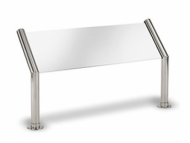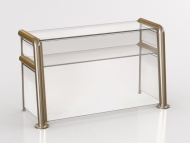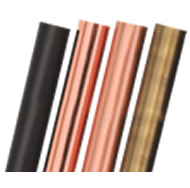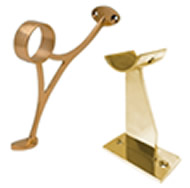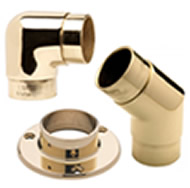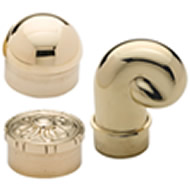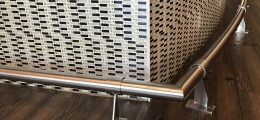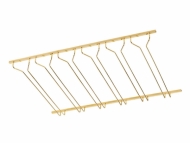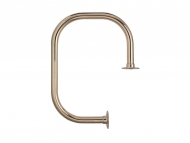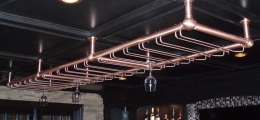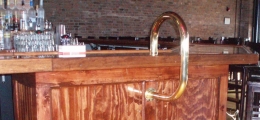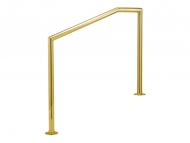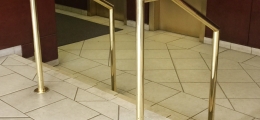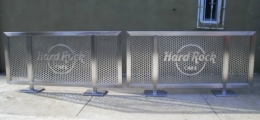Keeping your bartop smooth doesn’t just keep it looking good, it keeps it cleaner and safer, too. Cracks and fissures are unsightly, allow grime to collect, and can catch and spill glassware. If your epoxy bartop is beginning to show its age, worry not—you can get it looking and working as good as it did the day it was installed.
Even though epoxy is hard and resistant to most things you can throw at it, it can still be scratched by anything harder than itself.
What Are Epoxy Bartops Made Of?
Epoxy is a liquid resin that, when properly mixed and applied to a base (usually wood, metal, or concrete) produces a hard, shiny surface. This surface is perfectly smooth, easy to clean, and very resistant to wear, liquids, and solvents. Epoxy coatings consist of two parts: the epoxy resin itself, and a hardening agent. Sometimes, pigments are added to the mixture to yield different colors, patterns, or faux finishes like faux marble. Epoxy produces a hard, strong surface, but it can crack or show scratches and other surface wear over time. For this reason, it’s good to know how to repair your bartop when the time comes.
How Epoxy Becomes Damaged
Even though epoxy is hard and resistant to most things you can throw at it, it can still be scratched by anything harder than itself. This includes your patrons’ jewelry, glassware, silverware, or even just tiny bits of sand or grit that get tracked in from outdoors. Over time, minor scratches can build up until your bartop is no longer the shiny, flawless surface it used to be.
Deeper scratches, chips, and other, more serious damage can occur if very heavy things are dropped on the surface (particularly items with sharp corners). Though epoxy is heat resistant, it isn’t heat proof—very hot items can soften the epoxy surface, leaving dips, depressions, or areas of opacity.
Repairing Small Surface Marks
Most surface scratches can be rubbed out with a little furniture polish. Just:
- Apply a quarter-sized dollop of furniture polish to the area.
- Rub in a small, circular motion.
This should help tiny scratches blend back into the rest of the bar surface.
Repairing Larger Scratches
Larger scratches can still vanish back into the surface, but it takes a little more work:
- Wet a piece of 660 grit sandpaper.
- Sand the scratch, moving the sandpaper parallel to the mark, until it disappears.
- Use a finer grit sandpaper to further smooth the sanded area, using small, circular motions.
- Clean away residue with water.
- Apply a small amount of furniture polish, and polish the area until it shines again.
Repairing Chips and Dings
Chips taken out of epoxy can’t just be sanded away like a scratch can, but they can still be filled:
- Clean the chipped area thoroughly with rubbing alcohol to remove any oily residue.
- Using a disposable cup, mix a small batch of a suitable epoxy resin following the manufacturer’s instructions.
- Fill the chip with resin, and smooth the surface with a putty knife or other hard, straight edge.
- Allow to dry per the manufacturer’s instructions.
- Using wet 660 grit sandpaper, sand the filled area to make it perfectly smooth and level.
- Follow with fine grit sandpaper to further smooth the area.
- Clean away residue with water.
- Apply some furniture polish, and polish the area until it shines again.
Things to Know
If you are performing a repair that calls for fresh epoxy, be sure to use the right type, as not all will be suitable for your repair. Similarly, always follow the manufacturer’s instructions when it comes to mixing your epoxy—never, ever eyeball the ratio of resin to hardener. Improperly mixed epoxy will not cure properly, and can become cloudy, full of bubbles, or even remain in a sticky, semi-liquid state that will be difficult to remove.
Epoxy sometimes forms small bubbles as it cures due to outgassing. These produce minor imperfections that aren’t likely to be noticed, but they can be removed by gently warming the resin with a hair dryer or embossing heat gun before it is completely dry. Epoxy is a popular bar surface, and it’s small wonder why. It is attractive, holds up to a lot of use, and simple to clean, maintain, and repair. Even if your bar surface is starting to show its age, you can follow these steps to restore it to its original beauty and functionality.
TAGS: bars, helpful tips, maintenance, bartenders

